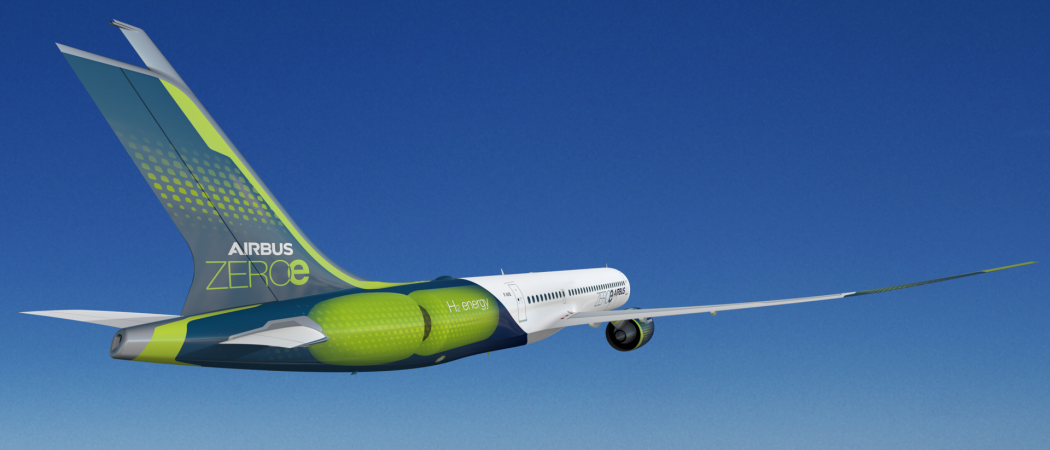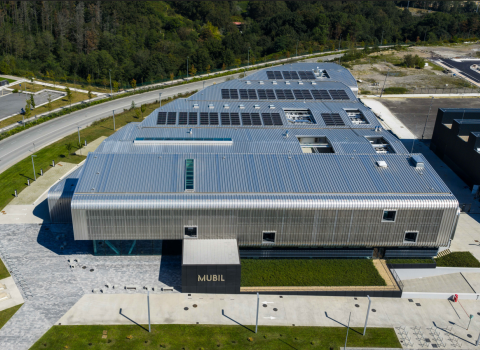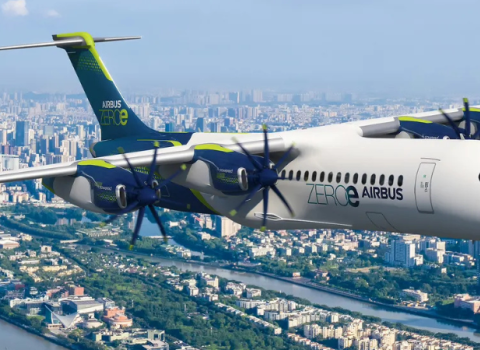Industry sees hydrogen as the route to sustainable air travel, but there is a long haul before it becomes a realistic alternative

Photo credits: AIRBUS
“We really believe in hydrogen for the future of aviation,” Guillaume Faury, CEO of Airbus told a meeting organised by the lobby group, the Aerospace, Security, and Defence Industries Association of Europe (ASD), in Brussels last week
But Faury noted, the main obstacle, will not be designing and building the planes, but overcoming the current shortcomings of hydrogen power, and installing the infrastructure needed to ensure adequate supplies of sustainable fuel.
Aviation accounts for between 2% and 2.5% of global CO2 emissions, but this is predicted to increase in the coming decades if no action is taken, as more and more flights take off.
Hydrogen is one of several possible replacements for kerosene and is gradually establishing itself as the technology of choice in Europe, but is a long way off being technologically and commercially viable.
However, the alternatives do not provide a route to CO2-free flying. Barring a technological breakthrough, batteries are too heavy to be suitable. Another contender, sustainable aviation fuel (SAF), produced from renewable or waste materials, is compatible with existing aircraft and infrastructure and its environmental impact is much lower than kerosene, but SAF still releases CO2 into the atmosphere.
Given these constraints, hydrogen is seen as the more long-term solution, but it is not without its share of obstacles. Because of its low density, the gas would have to be liquified and stored at -253 Celsius, but even in this liquid form it occupies three times the volume of kerosene for an identical amount of energy.
“This means completely redesigning the aircraft,” Roberto Cingolani, CEO of Italian multinational Leonardo, told the meeting.
Then there is the fact that as things stand most hydrogen is made by reforming natural gas, a process which releases large amounts of CO2 into the atmosphere. Green hydrogen, produced by the electrolysis of water using renewable electricity, is currently in very short supply, and aviation will be competing with other power-intensive industries.
“Green hydrogen at the moment costs €5 to €7 per kilo, so that would be considered more expensive than any other fuel,” Cingolani said. Hydrogen is promising, but “there’s a lot of work to be done”, he said.
Faury, who is president of ASD, expects installing the infrastructure to produce and distribute green hydrogen will be a more significant obstacle than the engineering challenge of redesigning aircraft. “It will probably arrive much after the time when we could have the plane,” he said. “We have to be faster on sustainable aviation fuels, because we will need SAF for probably longer than we thought.”
EU funding
Hydrogen is a focus of the EU’s Clean Aviation joint undertaking. “We are going to explore the opportunity to either burn hydrogen directly in an engine, or via fuel cell to establish electrical energy which can then propel the aircraft,” said its executive director Axel Krein.
The public-private partnership is aiming to deploy aircraft by 2035 that are 30% more fuel efficient, and allow CO2 reductions of up to 90% when combined with SAF or hydrogen.
SAF can refer to biofuels or e-fuels, which are made using captured CO2. Most of the discussion is around biofuels, but these are highly unlikely to provide the estimated 500 million tonnes of SAF that would be needed annually by 2050, said Krein.
“When you look at those amounts, I see the only opportunity is e-fuels, because they’re scalable. And when you look at the cost of e-fuels in comparison to hydrogen, it doesn’t look so brilliant for the e-fuels,” he said.
Hypersonic flight
While the Clean Aviation partnership is focused on technologies for regional and short and medium-range aircraft, Swiss start-up Destinus has its sights set on transatlantic and global flights.
The aircraft manufacturer has the target of building a hypersonic plane by 2035. Whereas supersonic aircraft like the Anglo-French Concorde travel faster than the speed of sound, hypersonic refers to speeds above Mach 5, or five times the speed of sound.
“If you want to make vehicles that fly really fast, they get really hot, so you need a coolant. Cryogenic fuels are the ideal thing for that, so you’re adding a purpose to the cold fuel,” said Bart Van Hove, head of advanced studies at Destinus.
NASA archives show scientists have been considering the use of hydrogen to achieve high speeds since the 1950s, and that work ended up being used in the Space Shuttle, but building large hypersonic aircraft was deemed too difficult, since they must be flat and sharp, Van Hove said.
Despite its low density, Van Hove says hydrogen can be an efficient fuel at high speeds. “It would take these aeroplanes 20,000 kilometres to the other end of the world in one go, if they fly at five to six times the speed of sound and if they’re large enough,” he told Science|Business.
Even adapting an existing engine for a future hydrogen-powered, hypersonic plane would cost at least several billion euros, according to Van Hove’s estimates. That is a world away from Destinus’ €100 million in private funding, in addition to a few grants from the EU and the Spanish government.
Collaborative projects at the European level could be the answer. Van Hove argues many existing EU projects are dominated by large companies, which have less incentive to innovate fast than start-ups fighting for their survival.
“What we need is to fund test flights that involve companies that can get things to fly very quickly, not only those long-term R&D projects that will probably just stagnate in some large industry eventually, when the hype is over,” he said.
In the meantime, Destinus has opened a liquid hydrogen test facility in Switzerland, which it also plans to rent out to scientists, universities and businesses developing hydrogen applications.
Destinus is a dual-use company, having begun selling drones to Ukraine as a way to boost revenues and test its technologies. Recently, several high-profile reports have called for the EU to embrace dual-use R&I. Van Hove argues member states are currently too concerned with supporting national industries with their defence budgets.
“If a company is getting the money it needs now, they probably don't want to enter a competition which they will perceive as a lottery across the continent, but I think that's exactly what we need: to start some competition and some innovation,” he said.





 A unique international forum for public research organisations and companies to connect their external engagement with strategic interests around their R&D system.
A unique international forum for public research organisations and companies to connect their external engagement with strategic interests around their R&D system.